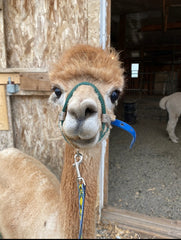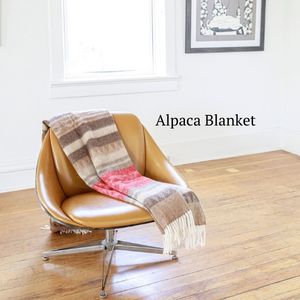Two weeks ago we walked through our lady alpacas in the evening, checking on everyone at a glance. We noticed one of our females--Truffles--laying down, shaking her head a bit. Because of her behavior, we assumed it was ear mites even though we have not had mites in years.
The next morning, we caught Truffles and examined her ears. When James put his finger in her right ear, there was a blockage. He slowly pulled out a glob about the size of a marble. Part of it was hard, other parts gooey and all of it smelled bad. At that point, we noticed there was a sag and paralysis on the right side of her face. Her main eyelid was not blinking, but her third eyelid still blinked. She was chewing on her left side of her jaw and breathing through her left nasal passage. Not good.
The next day we taught the Camelid handling program for the MSU vet students and our vet took a look at her directly. Truffles was unstable in her walking, though she could walk in a circle in both directions. She stumbled a bit walking in a straight line but fortunately ate pellets vigorously. However, she was drooling out of the side of her mouth. She is pregnant and has a 3-month cria at her side. Truffles is losing weight rapidly and is currently at 138 pounds.

We weighed Truffles and gave her Exceed ( 1.5 cc per 100 lbs, repeat in 5 days, sub-q, no more than 10 mils per spot) and Banamine (Also called Prevail: 1cc / 100 lbs).
This gave us a band-aid solution and gave us enough time to make phone calls to our trusted vets at both Washington State University and Colorado State University.
The experts told us that this is most likely a right otitis media and probably extends into the inner ear as well (otitis interna). The original cause is unknown but the most common thing that starts these issues are ear ticks. We recommend that you check your herd for ticks and also recommend routine treatments. Using Catron IV Fly Spray in both ears for all animals every 3-4 months does a good job at keeping ear ticks under control.
Otitis media is hard to treat on its own since the ear canal is long, slender, and in alpacas does a little loop that makes it very difficult to drain. Additionally, the facial nerve runs right along the tympanic bulla and becomes affected when these areas are inflamed. Our best success has been with an ear cleaning done under anesthesia by the dermatology service using a very small video endoscope to examine the ear canal and middle ear to make sure they get everything. They then used a compounded topical ear treatment that has been pretty effective. We always recommend a CT of the tympanic bulla at the same time to evaluate the inner ear because infection and abscessing of the inner ear rarely is resolved without surgery.

As for costs, these are estimated ranges:
Exam, Derm Consult, anesthesia and endoscopic ear cleaning: $700
A CT scan adds an additional $1500.
Surgery adds an additional $1500. We try to do them all under one anesthesia, but sometimes they have to be staggered.
We estimate that this whole process usually costs $4000-$5000. Getting a CT scan is the most important indicator as to whether surgery is necessary or not. You can always try a full ear cleaning and further medical treatment to see how it goes and therefore aid in your decision making regarding whether or not to pursue surgery. As for antibiotics, NuFlor is a good choice but topical ear treatment is also very important; however, it is only really helpful if the ear canal is fully cleaned.
- What is the likely outcome if my alpaca is only treated with systemic antibiotics, because topical antibiotics will not penetrate the gook? You're likely to see roughly a 30% chance of improvement but even with those, maybe a 50% chance of an incomplete cure that results in recurrence

- Since the facial nerve has already been damaged, is there any chance it will come back if treated as recommended? Caught and treated within the first 2 weeks of signs of ear droop and head tilt, the neurological signs resolve about 70% of the time; however, resolution of those takes time as the nerve needs to regenerate and will do that at only about 1 cm per month. It can take up to 12 months for full resolution.
- If treated as recommended, statistically what are the chances of a full recovery with and without nerve generation? If the trauma is located only in the middle ear, then about 60-70% of alpacas will recover with the previously recommended drugs. If the middle ear is infected and has abscessed, then systemic antibiotics alone are rarely successful. The key is that you treat your alpaca for a month and if there is improvement, keep going. If no or limited improvement is seen, stop immediately. If the inner ear is affected and surgery is an option, then success is near 80%. The big question with surgeries is the facial nerve. Luckily, some function almost always returns.
- How long do you think my alpaca will need to stay with a vet? An overnight trip and we head home or we come back at a later date? If just the endoscopic flush +/- the CT, then you can head home the next day. If your alpaca requires surgery, it depends on how they recover and what is found during surgery. It may be 2 or 3 days, but generally, you can go home fairly soon on antibiotics.
-
Should I start the NuFlor now or wait until a decision is made for treatment? Start now.

- The persistent bacteria growing in the ear appears to be Trueperella. Will NuFlor work? Many antibiotics work, including NuFlor. Probably the best antibiotic for T. pyogenes is actually regular Procaine Penicillin at 1 ml per 30 lb BW twice daily. The downside to this treatment is the frequent injections, but the upside is that it is very effective. Some people will argue that it will not penetrate as well as NuFlor into the infected area, but with the long-term treatment I feel it is generally just as effective or more effective than NuFlor. It is also bactericidal where NuFlor is bacteriostatic. Either way, you will be treating your alpaca for at least a month. Cleaning the ear canal with the endoscope and adding the topical treatment also really improves the outcome.
We decided to adhere to the following treatment plan:
We opted out of surgery and treated her ear ourselves. We cleaned her ear out manually and then used Aurocin – Veterinary Formula Ear Cleansing Solution for Cats and Dogs.
Dexamethasone: 2 cc for three days in a row, skip a day, give another dose, sub-q
NuFlor – 40 mg/kg SQ every 4 days for at least a month
Enroflaxacin – a topical ointment that is put into the ear directly. This was done once immediately, and will be repeated in 14 days.
Penacillin / Bactracillin - 1cc / 100 lbs, 7 days in a row
Eye drops: To help her eyes not dry out until the facial nerves recover. 2-4 times per day.
On the 10th day, we noticed that there was slightly more tone in Truffles lips. She could blink her eyes and her right ear was starting to come forward again instead of laying limp. Hopefully she will continue to progress, although we are leery of getting our hopes up.
We hope this helps anyone else with a similar issue.
Join the alpaca revolution! Alpaca is a sustainable alternative that is not only good for the earth, but for all of us. Alpaca wool is stronger, softer, more eco-friendly, and offers 85% greater wicking capability than merino wool. It is also hypoallergenic! Learn more about the benefits of alpaca in our Alpaca vs. Wool blog posts, shop our collections and follow us on social media!



